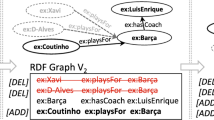Abstract
Data generation in RDF has been increasing over the last years as a means to publish heterogeneous and interconnected data. RDF is usually serialized in verbose text formats, which is problematic for publishing and managing huge datasets. HDT is a binary serialization of RDF that makes use of compact data structures, making it possible to publish and query highly compressed RDF data. This allows to reduce both the volume needed to store it and the speed at which it can be transferred or queried. However, it moves the burden of dealing with huge amounts of data from the consumer to the publisher, who needs to serialize the text data into HDT. This process consumes a lot of resources in terms of time, processing power, and especially memory. In addition, adding data to a file in HDT format is currently not possible, whether this additional data is in plain text or already serialized into HDT.
In this paper, we present HDTCat, a tool to merge the contents of two HDT files with low memory footprint. Apart from creating an HDT file with the added data of two or more datasets efficiently, this tool can be used in a divide-and-conquer strategy to generate HDT files from huge datasets with low memory consumption.
Access this chapter
Tax calculation will be finalised at checkout
Purchases are for personal use only
Similar content being viewed by others
Notes
- 1.
- 2.
- 3.
All files retrieved by: wget -r -nc -nH –cut-dirs=1 -np -l1 -A ‘*ttl.bz2’ -A ‘*.owl’-R ‘*unredirected*’–tries 2 http://downloads.dbpedia.org/2016-10/core-i18n/en/, i.e. all files published in the english DBpedia. We exclude the following files: nif_page_structure_en.ttl, raw_tables_en.ttl and page_links_en.ttl since they do not contain typical data used in application relying on DBpedia.
References
Brisaboa, N.R., Cánovas, R., Martínez-Prieto, M.A., Navarro, G.: Compressed string dictionaries. CoRR abs/1101.5506 (2011). http://arxiv.org/abs/1101.5506
Curé, O., Blin, G., Revuz, D., Faye, D.C.: WaterFowl: a compact, self-indexed and inference-enabled immutable RDF store. In: Presutti, V., d’Amato, C., Gandon, F., d’Aquin, M., Staab, S., Tordai, A. (eds.) ESWC 2014. LNCS, vol. 8465, pp. 302–316. Springer, Cham (2014). https://doi.org/10.1007/978-3-319-07443-6_21
Diefenbach, D., Both, A., Singh, K., Maret, P.: Towards a question answering system over the semantic web. Semant. Web J. 1–19 (2020)
Diefenbach, D., Singh, K., Maret, P.: WDAqua-core0: a question answering component for the research community. In: Dragoni, M., Solanki, M., Blomqvist, E. (eds.) SemWebEval 2017. CCIS, vol. 769, pp. 84–89. Springer, Cham (2017). https://doi.org/10.1007/978-3-319-69146-6_8
Fernández, J.D., Beek, W., Martínez-Prieto, M.A., Arias, M.: LOD-a-lot. In: d’Amato, C., et al. (eds.) ISWC 2017. LNCS, vol. 10588, pp. 75–83. Springer, Cham (2017). https://doi.org/10.1007/978-3-319-68204-4_7
Fernández, J.D., Martínez-Prieto, M.A., Gutiérrez, C., Polleres, A., Arias, M.: Binary RDF representation for publication and exchange (HDT). J. Web Semant. 19(22–41), 00124 (2013)
Giménez-García, J.M., Fernández, J.D., Martínez-Prieto, M.A.: HDT-MR: a scalable solution for RDF compression with HDT and MapReduce. In: Gandon, F., Sabou, M., Sack, H., d’Amato, C., Cudré-Mauroux, P., Zimmermann, A. (eds.) ESWC 2015. LNCS, vol. 9088, pp. 253–268. Springer, Cham (2015). https://doi.org/10.1007/978-3-319-18818-8_16
Guo, Y., Pan, Z., Heflin, J.: LUBM: a benchmark for OWL knowledge base systems. J. Web Semant. 3(2), 158–182 (2005)
Gutierrez, C., Hurtado, C.A., Mendelzon, A.O., Pérez, J.: Foundations of semantic web databases. J. Comput. Syst. Sci. 77(3), 520–541 (2011). https://doi.org/10.1016/j.jcss.2010.04.009
Hu, T.C., Tucker, A.C.: Optimal computer search trees and variable-length alphabetical codes. Siam J. Appl. Math. 21(4), 514–532 (1971)
Martínez-Prieto, M., Arias, M., Fernández, J.: Exchange and consumption of huge RDF data. In: Proceeding of ESWC, pp. 437–452 (2012)
Verborgh, R., et al.: Querying Datasets on the Web with High Availability. In: Mika, Peter, Tudorache, Tania, Bernstein, Abraham, Welty, Chris, Knoblock, Craig, Vrandečić, Denny, Groth, Paul, Noy, Natasha, Janowicz, Krzysztof, Goble, Carole (eds.) ISWC 2014. LNCS, vol. 8796, pp. 180–196. Springer, Cham (2014). https://doi.org/10.1007/978-3-319-11964-9_12, http://linkeddatafragments.org/publications/iswc2014.pdf
Acknowledgements
We would like to thank Pedro Migliatti for executing part of the experiments as well as Javier D. Fernández for the helpful discussions with him. We also want to thank Dimitris Nikolopoulos and Wouter Beek from Triply for porting the algorithm to C++. This project has received funding from the European Union’s Horizon 2020 research and innovation program under the Marie Sklodowska-Curie grant agreement No 642795.
Author information
Authors and Affiliations
Corresponding author
Editor information
Editors and Affiliations
Rights and permissions
Copyright information
© 2020 Springer Nature Switzerland AG
About this paper
Cite this paper
Diefenbach, D., Giménez-García, J.M. (2020). HDTCat: Let’s Make HDT Generation Scale. In: Pan, J.Z., et al. The Semantic Web – ISWC 2020. ISWC 2020. Lecture Notes in Computer Science(), vol 12507. Springer, Cham. https://doi.org/10.1007/978-3-030-62466-8_2
Download citation
DOI: https://doi.org/10.1007/978-3-030-62466-8_2
Published:
Publisher Name: Springer, Cham
Print ISBN: 978-3-030-62465-1
Online ISBN: 978-3-030-62466-8
eBook Packages: Computer ScienceComputer Science (R0)





